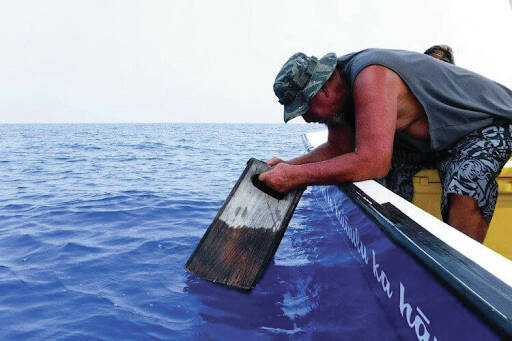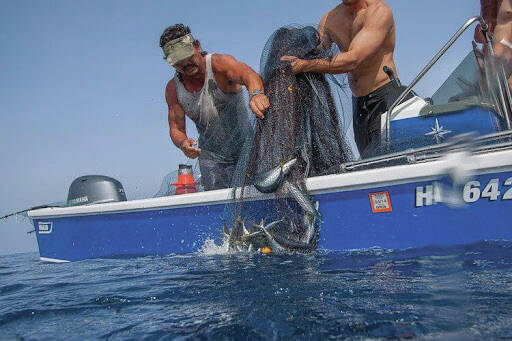A matter of time
I first came across the Hawaiian term kipuka while out hunting here on Big Island. In a terrestrial habitat, kipuka are oases of vegetation and life in an otherwise barren lava flow.
Come to find now that there can be all sorts of kipuka. A calm spot in a rough ocean is a kipuka. A glimpse of blue sky through storm clouds is too. From here, it is easy to see that the term kipuka could take on all sorts of meanings and relevance, depending on how deep one wants to dive into the concept.
Nowhere is this more apparent than down in the tiny village of Milolii. One of the last remaining fishing villages in Hawaii, it is an area where native Hawaiian traditional and cultural practices remain active, while western ways swarm all around. This is what scholars call a “cultural kipuka.”
The village is also surrounded by lava flows, so it fits the physical example as well. In the ocean, villagers take the concept into nearshore waters and create kipuka refuges (puuhonua) for fish and reef creatures to flourish whereas zones outside may be dwindling. Community members are working with the state to establish a Community Based Subsistence Fishing Area.
To villagers this is not a new concept. To them, it is returning to the ways of the Konohiki, the traditional land managers whose kuleana (responsibility) was to ensure that everyone is well fed in the ahupua’a (land division). In 2005, Milolii became the fist community to be recognized by the state as a Community Based Subsistence Fishing Area (CBSFA). CBSFA’s reaffirm and protect subsistence fishing practices of Native Hawaiian culture and tradition.
The amount of fishing pressure down there is deceiving due to vastness of space. This deception is enabled by the slopes of Mauna Loa disappearing into clouds and an ocean horizon that can be seen but never found. It’s as if time is infinite, allowing villagers to rely upon the old ways for managing marine resources, when Western ones fail.
Conversely to the deception, fishers come from all over with every new gadget and type of gear on the market. Simultaneously, the establishment of a traditional fishery management system during modern times is to step foot into a maze of time consuming procedures with the state government.
With one foot in the West and the other in the past, it would be easy for frustrated leaders to do the hokey pokey with the state – pull that foot out and just go back to the village. After 40 years of working on this project, their leaders seem to have adopted this mantra instead: “What’s another year or three when we’ve already been here forever?”
One such person is Kaimi Kaupiko, President and Co-Founder of the 501(c)3 non-profit, Kalanihale, established in 2012. Their mission: improve the educational, environmental, and cultural well-being of community members in Milolii and South Kona.
Kaupiko and an ever-growing team have established the Milolii Hipuu Virtual Academy of Kua o ka La New Century Public Charter School. They have also convened Milolii Lawai Ohana fishing camps with Conservation International and a traditional fishing program to raise opelu in partnership with another local nonprofit – Pa’a Pono Milolii (PPM) – founded in 1980.
It was not until 2015, however, that Kalanihale and PPM returned to the grueling task of establishing all of the components that go into actually establishing and operating a CBSFA.
According to Kaupiko, “It was time for us the heed the calls of our kupuna, to draw inspiration from their love of place and their vast knowledge of traditional fishing.”
One of the first things they did was conduct “kanaka testimonies” by interviewing 65 members of 50 local families with the purpose of understanding their relationship to and perceptions of, Milolii’s marine resources. 97% responding indicated marine resources were more abundant in the past. The community figured this was due to climate change, water quality degradation, over harvest and modern fishing gear such as monofilament nets, spear guns and harvesting reef fish for aquariums.
They identified 14 species of fish and invertebrates in peril. Biological surveys conducted between 2008 and 2018 showed a 45% decline in reef fish populations for all of West Hawaii. More troubling was that reef fish had declined 57% within the area designated as the Milolii CBSFA.
According to Milolii CBSFA documents, a team of Western researchers were able to establish direct correlations between reef fish decline and wastewater effluent, spearfishing and aquarium collecting – as predicted. This resounded solidly with the team that their efforts were both timely and critically important.
The Milolii CBSFA Management Plan document is 76 pages long. From page 18 until the end, a reader finds a concise list of goals, objectives and activities as well as an impressive set of tables, maps, budgets, definitions, citations, legalese and a comprehensive list of proposed regulations, itemized by marine species.
All of this work over all these years is a short walk on the long road of State Chapter 91 process of establishing DAR Administrative Rules. The plan is in the public scoping process now. From there, DAR has to draft the proposed rules; then they face approval by the attorney general’s office. If that passes, then the project needs both BLNR and the governor’s approval to hold public hearings. DAR will revise any rules deemed necessary from public hearings. The plan returns to the AG’s office then back to BLNR for final approval rule making. Finally, the governor’s office must issue final approval. Once the CBSFA is formally established under DAR admin rules, it has the same force of law as statewide regulations.
For folks who live in the tranquility of South Kona, all of this “Western” humbug could easily be seen as too daunting. It would be easy to understand if they just did one final hokey pokey, pulled their foot out and ran – not walked – away from the bureaucracy.
That these folks continue to persevere and press on shows incredible tenacity, but moreover it shows an undying belief in their culture along with the knowledge that the old ways work.
For more information please visit: www.kalanihale.com



